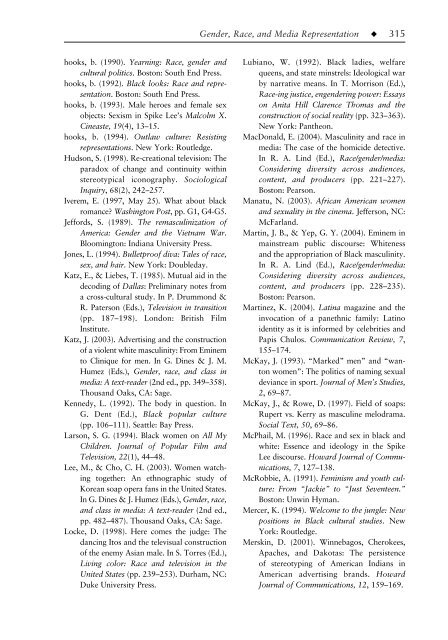Gender, race, and media representation - afghan
Gender, race, and media representation - afghan
Gender, race, and media representation - afghan
Create successful ePaper yourself
Turn your PDF publications into a flip-book with our unique Google optimized e-Paper software.
16-Dow-4973.qxd 6/11/2006 1:42 PM Page 315<br />
hooks, b. (1990). Yearning: Race, gender <strong>and</strong><br />
cultural politics. Boston: South End Press.<br />
hooks, b. (1992). Black looks: Race <strong>and</strong> <strong>representation</strong>.<br />
Boston: South End Press.<br />
hooks, b. (1993). Male heroes <strong>and</strong> female sex<br />
objects: Sexism in Spike Lee’s Malcolm X.<br />
Cineaste, 19(4), 13–15.<br />
hooks, b. (1994). Outlaw culture: Resisting<br />
<strong>representation</strong>s. New York: Routledge.<br />
Hudson, S. (1998). Re-creational television: The<br />
paradox of change <strong>and</strong> continuity within<br />
stereotypical iconography. Sociological<br />
Inquiry, 68(2), 242–257.<br />
Iverem, E. (1997, May 25). What about black<br />
romance? Washington Post, pp. G1, G4-G5.<br />
Jeffords, S. (1989). The remasculinization of<br />
America: <strong>Gender</strong> <strong>and</strong> the Vietnam War.<br />
Bloomington: Indiana University Press.<br />
Jones, L. (1994). Bulletproof diva: Tales of <strong>race</strong>,<br />
sex, <strong>and</strong> hair. New York: Doubleday.<br />
Katz, E., & Liebes, T. (1985). Mutual aid in the<br />
decoding of Dallas: Preliminary notes from<br />
a cross-cultural study. In P. Drummond &<br />
R. Paterson (Eds.), Television in transition<br />
(pp. 187–198). London: British Film<br />
Institute.<br />
Katz, J. (2003). Advertising <strong>and</strong> the construction<br />
of a violent white masculinity: From Eminem<br />
to Clinique for men. In G. Dines & J. M.<br />
Humez (Eds.), <strong>Gender</strong>, <strong>race</strong>, <strong>and</strong> class in<br />
<strong>media</strong>: A text-reader (2nd ed., pp. 349–358).<br />
Thous<strong>and</strong> Oaks, CA: Sage.<br />
Kennedy, L. (1992). The body in question. In<br />
G. Dent (Ed.), Black popular culture<br />
(pp. 106–111). Seattle: Bay Press.<br />
Larson, S. G. (1994). Black women on All My<br />
Children. Journal of Popular Film <strong>and</strong><br />
Television, 22(1), 44–48.<br />
Lee, M., & Cho, C. H. (2003). Women watching<br />
together: An ethnographic study of<br />
Korean soap opera fans in the United States.<br />
In G. Dines & J. Humez (Eds.), <strong>Gender</strong>, <strong>race</strong>,<br />
<strong>and</strong> class in <strong>media</strong>: A text-reader (2nd ed.,<br />
pp. 482–487). Thous<strong>and</strong> Oaks, CA: Sage.<br />
Locke, D. (1998). Here comes the judge: The<br />
dancing Itos <strong>and</strong> the televisual construction<br />
of the enemy Asian male. In S. Torres (Ed.),<br />
Living color: Race <strong>and</strong> television in the<br />
United States (pp. 239–253). Durham, NC:<br />
Duke University Press.<br />
<strong>Gender</strong>, Race, <strong>and</strong> Media Representation–––◆–––315<br />
Lubiano, W. (1992). Black ladies, welfare<br />
queens, <strong>and</strong> state minstrels: Ideological war<br />
by narrative means. In T. Morrison (Ed.),<br />
Race-ing justice, engendering power: Essays<br />
on Anita Hill Clarence Thomas <strong>and</strong> the<br />
construction of social reality (pp. 323–363).<br />
New York: Pantheon.<br />
MacDonald, E. (2004). Masculinity <strong>and</strong> <strong>race</strong> in<br />
<strong>media</strong>: The case of the homicide detective.<br />
In R. A. Lind (Ed.), Race/gender/<strong>media</strong>:<br />
Considering diversity across audiences,<br />
content, <strong>and</strong> producers (pp. 221–227).<br />
Boston: Pearson.<br />
Manatu, N. (2003). African American women<br />
<strong>and</strong> sexuality in the cinema. Jefferson, NC:<br />
McFarl<strong>and</strong>.<br />
Martin, J. B., & Yep, G. Y. (2004). Eminem in<br />
mainstream public discourse: Whiteness<br />
<strong>and</strong> the appropriation of Black masculinity.<br />
In R. A. Lind (Ed.), Race/gender/<strong>media</strong>:<br />
Considering diversity across audiences,<br />
content, <strong>and</strong> producers (pp. 228–235).<br />
Boston: Pearson.<br />
Martinez, K. (2004). Latina magazine <strong>and</strong> the<br />
invocation of a panethnic family: Latino<br />
identity as it is informed by celebrities <strong>and</strong><br />
Papis Chulos. Communication Review, 7,<br />
155–174.<br />
McKay, J. (1993). “Marked” men” <strong>and</strong> “wanton<br />
women”: The politics of naming sexual<br />
deviance in sport. Journal of Men’s Studies,<br />
2, 69–87.<br />
McKay, J., & Rowe, D. (1997). Field of soaps:<br />
Rupert vs. Kerry as masculine melodrama.<br />
Social Text, 50, 69–86.<br />
McPhail, M. (1996). Race <strong>and</strong> sex in black <strong>and</strong><br />
white: Essence <strong>and</strong> ideology in the Spike<br />
Lee discourse. Howard Journal of Communications,<br />
7, 127–138.<br />
McRobbie, A. (1991). Feminism <strong>and</strong> youth culture:<br />
From “Jackie” to “Just Seventeen.”<br />
Boston: Unwin Hyman.<br />
Mercer, K. (1994). Welcome to the jungle: New<br />
positions in Black cultural studies. New<br />
York: Routledge.<br />
Merskin, D. (2001). Winnebagos, Cherokees,<br />
Apaches, <strong>and</strong> Dakotas: The persistence<br />
of stereotyping of American Indians in<br />
American advertising br<strong>and</strong>s. Howard<br />
Journal of Communications, 12, 159–169.




